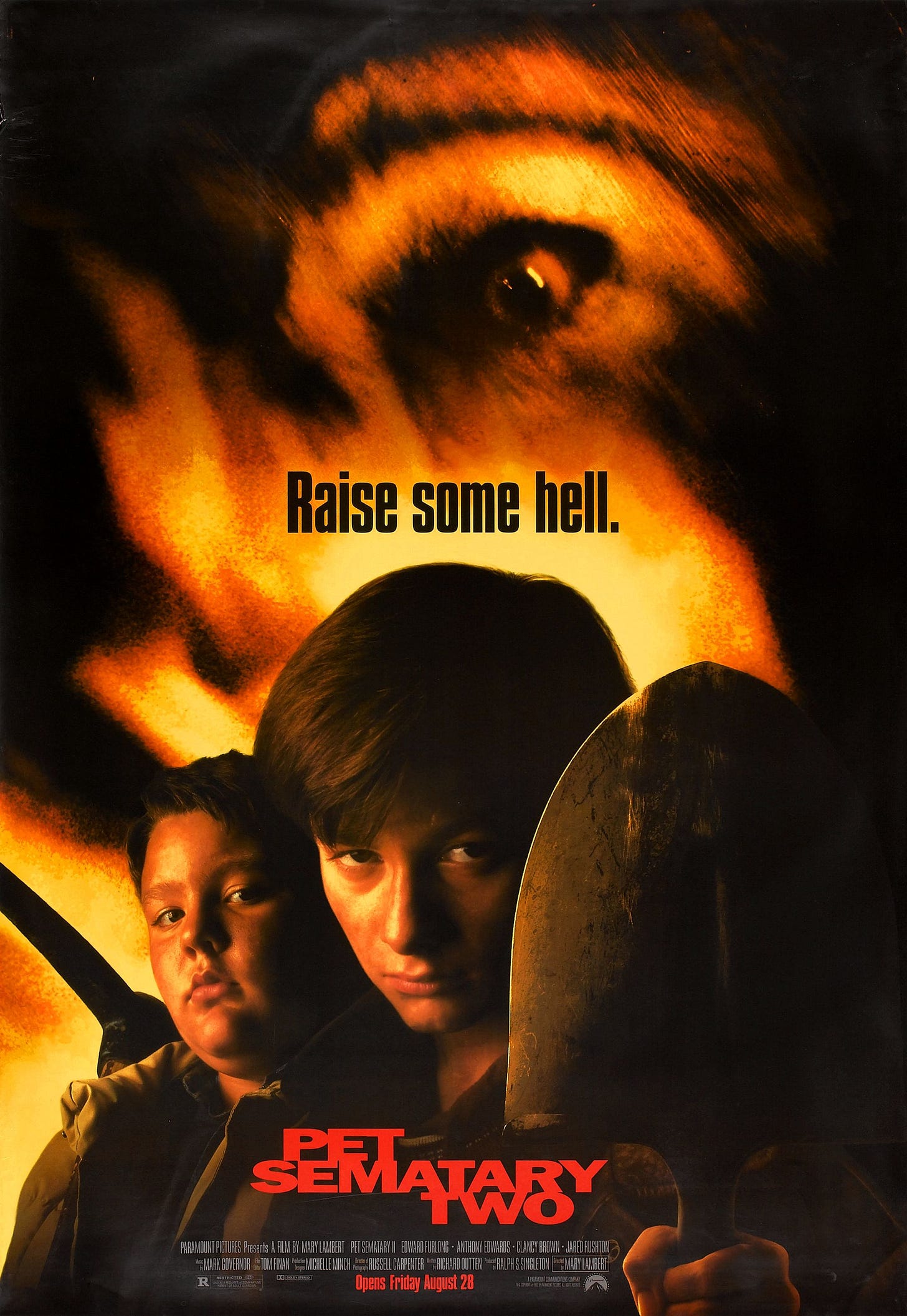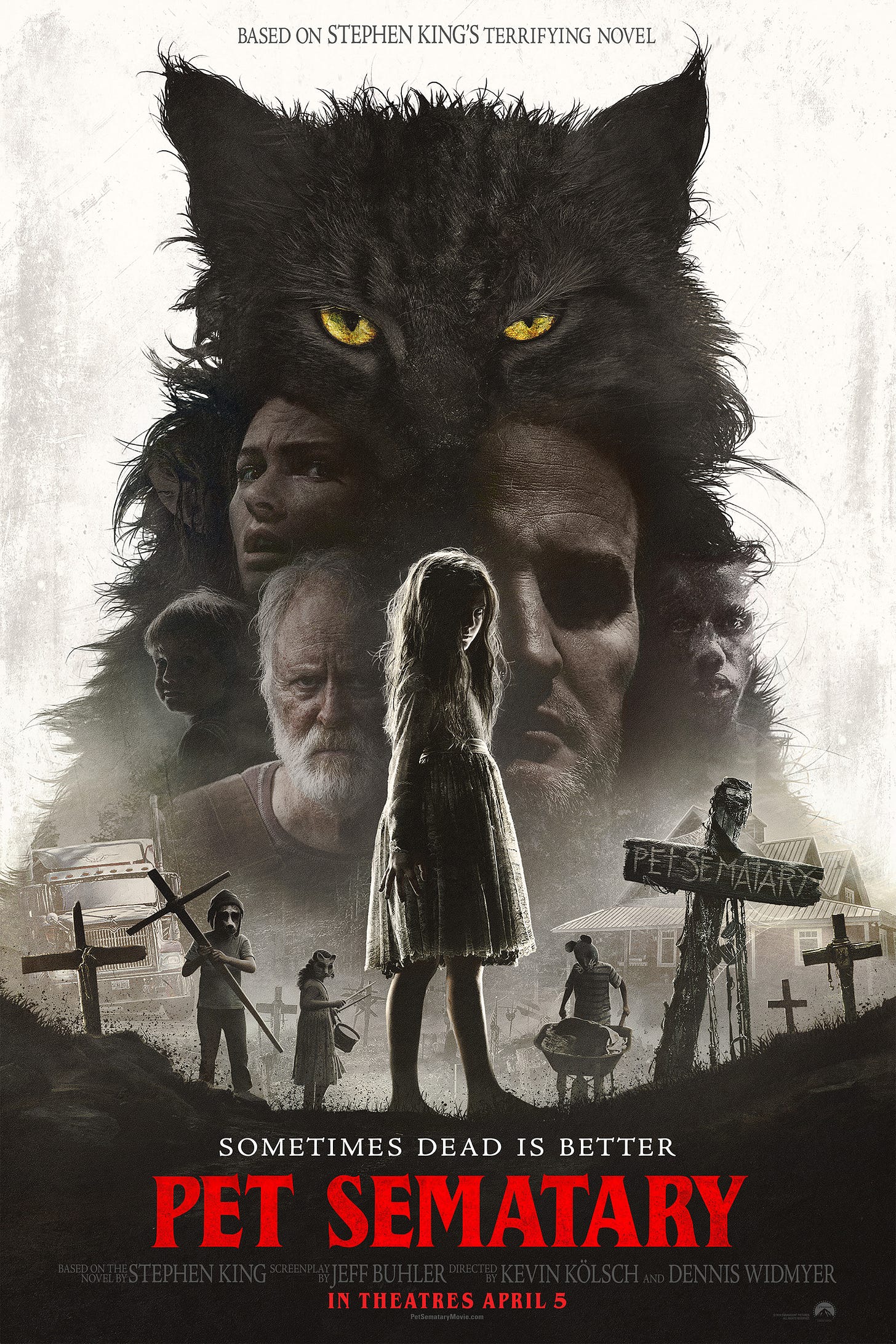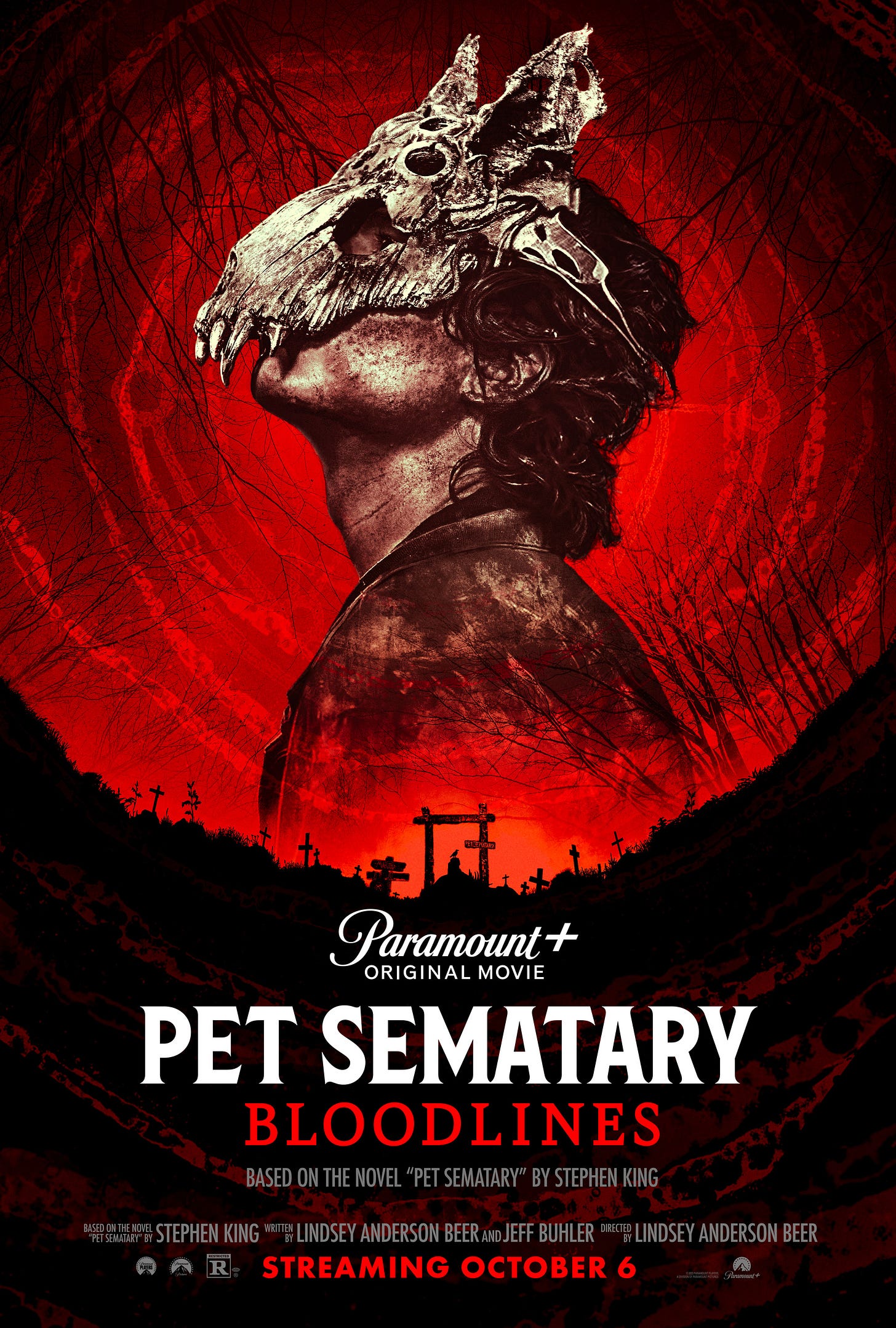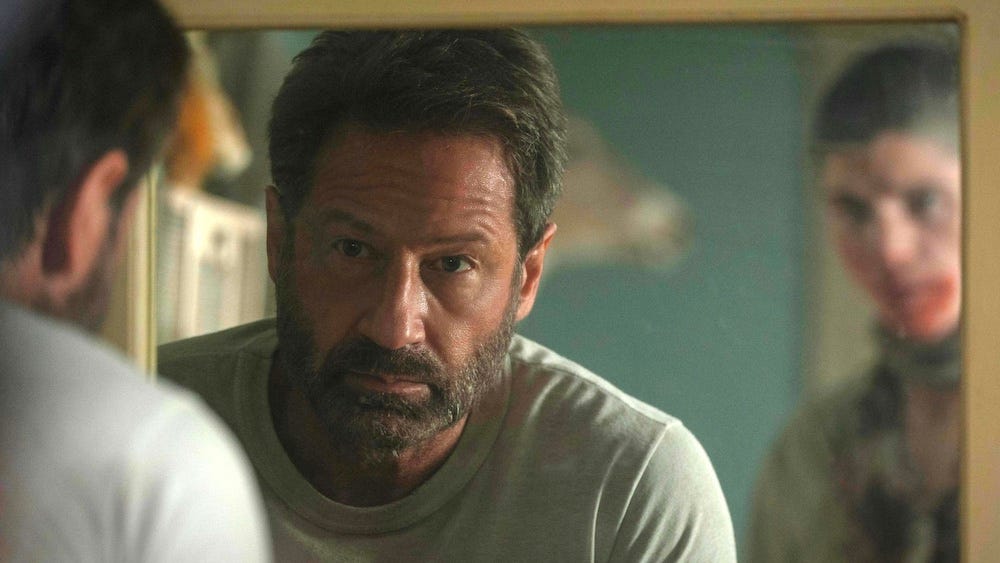

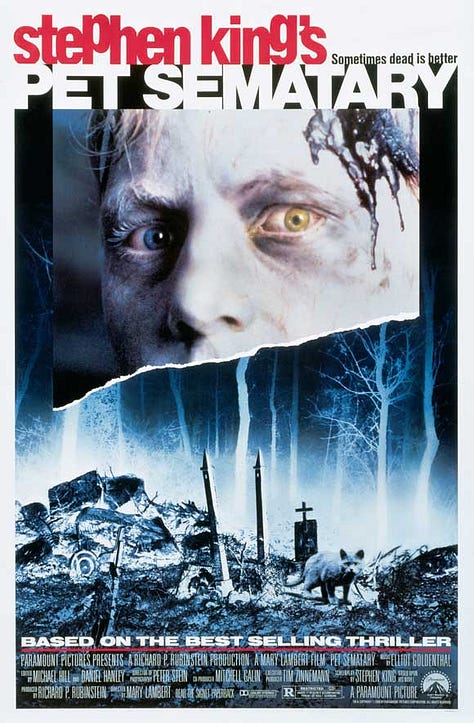
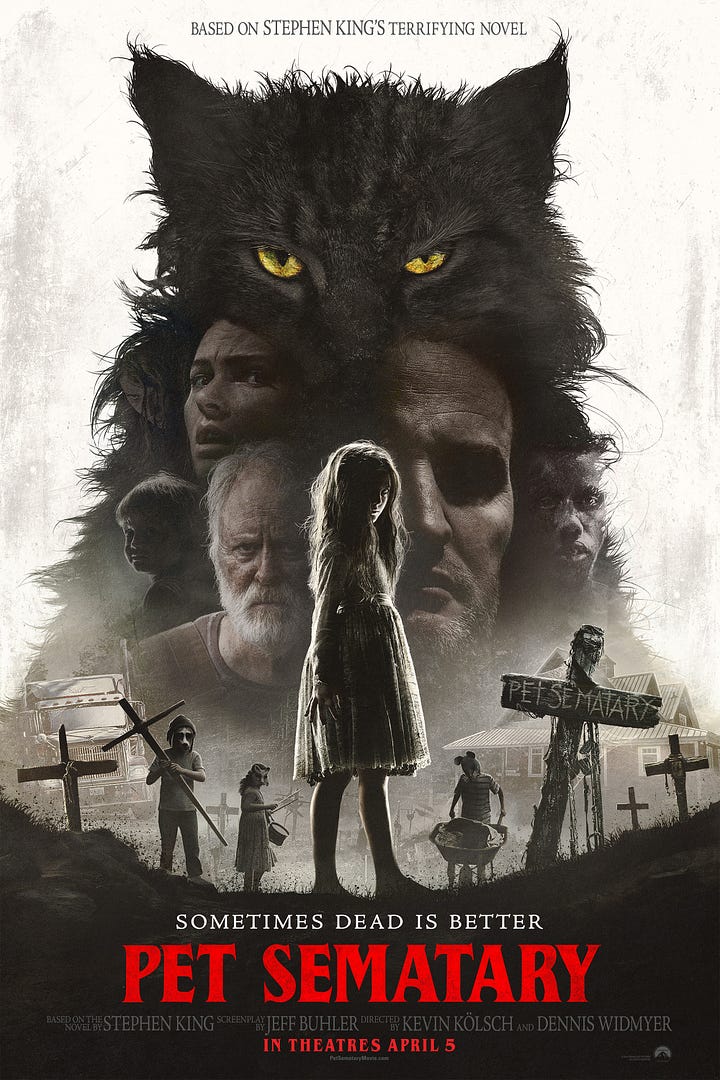
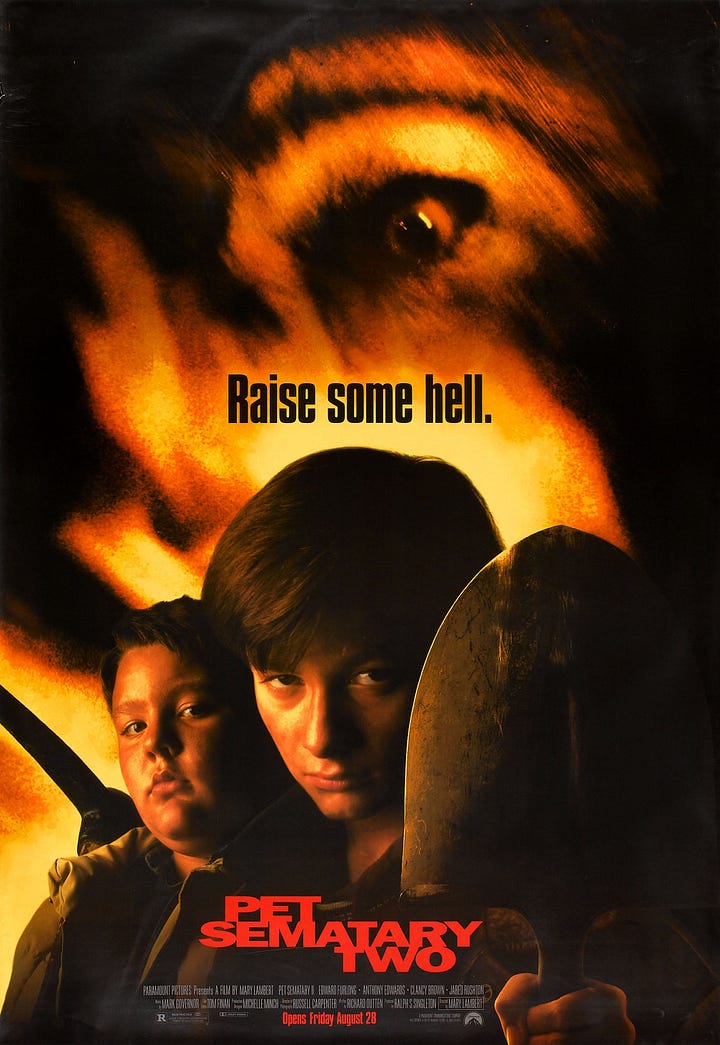
(WARNING: SPOILERS FOR THE NOVEL AND ALL FOUR FILMS TO FOLLOW)
Stephen King is one of the most popular authors of the 20th and 21st centuries. His stories have haunted the imagination of generations and inspired countless movies, novels, television shows, and nightmares. One of his most popular stories, one that has been adapted into four films, is Pet Semetary, which tells the story of a doctor who moves to a small New England town only to be swept up in the madness of an ancient cemetery that revives the dead. Each iteration of the story, from the two director adaptations, the sequel to the original adaptation, and the prequel to the newer one, brings new themes and ideas to this initial story. While there are echoes that ring from one adaptation to the others, it’s the unique visions that directors are able to bring that make this material something to return to again and again.
Whether it’s the cursed demons of what we should have done, the dreams of a life you could have had, or the burden of destiny, the various stories told within the umbrella that is the pet semetary are distinct. The shifting perspectives of each of these tales allow for exploration in the story, from a middle-aged couple looking for the perfect picket-fenced life to a teenage boy looking for a semblance of normalcy. The power of the pet semetary is undeniable, and the calling of the evil forces that lie within the forests of Ludlow are as irresistible as they are dangerous.
Stephen King’s original novel follows Louis Creed as he moves his young family to the small, rural community. Nestled deep into the woods, and with a deed to a massive area of land that includes the Pet Semetary, the novel sets up the Creed family as a standard, white-bread American middle-class household. The parents love each other even when they disagree, the children are just as bright and just as dumb as a six-year-old and a two-year-old would be. The horror of the novel begins after the death of their two-year-old son, Gage, after he is struck by a speeding semi-truck on the highway beside their house. Louis, driven insane from grief, eventually digs up Gage and buries him in the Pet Semetary, leading to his death, his wife’s death, and the death of his friend Jud Crandell.
The novel is mostly about the fear of failure a father holds. Stephen King, during the time of writing the novel, was in the grips of addiction and alcoholism, and the fear and pain that comes with demons and fatherhood created the horror of the novel. Louis Creed, ultimately, sees himself as a failure. He is an accomplished doctor, a loving husband, an attentive father, but in the end, nothing could have saved his son from a speeding truck and a moment of distraction. So when presented with the idea of the pet semetary, with the possibility of redemption, he had no choice. But it’s a sour redemption, a rotting promise, much like how the promise of one more drink will drown the pain. The pet semetary calls, beckons, caresses the soul, but the hands that hold Louis’ hopes are cold and dead and gripping tight enough to crush.
The evil presence that lies within the pet semetary is much more pervasive in the novel than in the films. It beckons to Louis, gently, even before he is aware of its power. It poisons Jud’s mind until he reveals its secrets, guiding Louis up the circles of hell that lay beyond the deadfall. It even influences the semi-driver, gently easing his worries until he is speeding out of control. The pet semetary has something to offer to everybody, a delicious, succulent disease. Louis’ redemption, Jud the love of a child he never had, the truck driver's simple ease of mind. While the novel has much more time and space to explore this idea than a film would ever be granted, it is the major element that the adaptations seem to lack. The call of the pet semetary is something every man taken by it wants. There is a choice in the matter, and all of them slide down the path of least resistance with neither a quarry nor quiver.
The distillation of this leads to familiar themes within the first film, 1989’s Pet Semetary, directed by Mary Lambert. The beats of the novel are nearly identical; Louis, Rachel, Elle, and Gage Creed move to the sleepy college town of Ludlow only for tragedy to befall them. The major difference between the novel and the film is the exclusion of Norma Crandall, Jud’s beloved wife, and instead including a nanny named Missy Dandridge. This departure, while slight, introduces death to our story in different ways. Within the novel, Norma suffers a near-fatal heart attack one night and is saved by Louis. Though she later does pass, the relationship between Jud and Louis is bound in blood over the saving of Norma’s life. Within the film Missy Dandridge introduces death in a sudden, shocking way, committing suicide after being unable to handle the pain of stomach cancer. Though Louis briefly offered her aide for her pain, it wasn’t enough to save her this time. Missy’s death is less about bonding the two friends of Jud and Louis and more about showing the failure that Louis could be. Louis’ intentions, no matter how golden, are not strong enough.
The film is less about the enticing call of the forbidden fruit and more about the failures of man. With the whispers from the semetary being so prominent, the film relies more on the direct actions of Louis. Louis is shown unable to stop Gage from running into traffic, unlike in the novel, where we only find out about Gage’s death after the fact. By placing us in the moment Louis loses Gage, the filmmakers directly show us how Louis could see this as a failure. He didn’t stop it, he didn’t protect his family, just like he couldn’t help Missy. The pet semetary is not a ghost beckoning him from beyond but simply a tool to undo his mistake. It’s less about the desires of our darkest moments, and more about our desire for forgiveness.
The film and the novel end on the same beats, but they ring differently. After killing the reanimated Gage, Louis takes Rachel’s body to the semetary, believing that he waited too long to bury Gage and that the freshly killed Rachel will come back as she was before. In the novel, this comes off as pure insanity, a man who has lost everything he believed in and is now only a shell of himself, completely guided by the calls of the burial ground. We even have the character Steve Masterton (a colleague of Louis’) witness Louis carrying the body, and the call of the pet semetary almost entrances him as well. In the film, while there is still undoubtedly madness in the final actions of Louis, it is more pathetic than horrific. As Louis’ guiding angel Victor Pascow (a student who died in Louis’ office on the first day of classes) pleads for him to not go on this deadly quest, Louis is overcome yet again with grief, for he has failed again.
The novel ends with the raspy-voiced return of Rachel, who calls to Louis from the doorway of their home. In the film this scene is played out to its inevitable conclusion, showing the complete failure that has become Louis’ increasingly manic decisions. Rachel enters and the couple embraces, Louis ignoring her rotting, leaking face. She then grabs a knife and we cut to black as Louis screams. The more definitive ending of the film brings about a condemnation of our characters, smart people who should have known better than to chase the past. The audience needs to see their punishment, needs to see the story come full circle. In the novel, the madness that Louis has fallen into is punishment enough, and what becomes of him after Rachel returns is only an afterthought.
In the sequel to the original film, Mary Lambert had no source material to work from and thus had more freedom in exploring what the pet semetary could be. Pet Semetary 2 takes the formula of the first film and switches all the roles, and we follow characters who less want to change the past and more want to set right the present. The film follows Jeff Matthews (Edward Furlong) as he moves in with his father after the sudden death of his mother. Jeff quickly befriends Drew (Jason McGuire), a local boy whose stepfather is the overbearing local sheriff Gus (Clancy Brown). After an accident leads to the death of Gus, the boys bring him back, and the town is yet again thrown into chaos.
By switching the age of who dies and who gets left behind, the second film is able to explore different interpretations of grief. In the original film, Louis blames himself completely for the death of his son, and it’s this burden that eventually drives him to the semetary. In Pet Semetary 2, it’s Jeff’s wish for normality that drives him. He has no sense of blame for his mother’s death, and instead just wishes for everything to go back to the way things once were. Jeff wants to have a normal life, and in his mind, a kid without a mother would be incapable of this. Louis’ grief was focused on the past, while Jeff’s was imagining the future.
In the second film, the semetary is even less of a malevolent force. It’s been turned into a ghost story, a campfire tale for local kids. Neither Jeff nor Drew are drawn into the thrall of the burial ground, instead acting solely on fear and desperation. Much like the first film, the first creatures we see buried are pets. In the original, we see Ellie’s cat Church brought back, in the second Drew’s dog Zowie. Both animals come back vicious and evil, but the motives behind the burials foreshadow the reasoning behind the burial of loved ones. In the original, Jud sees it as kindness, and Louis agrees because the last thing he wants is to hurt his children in any way. In the sequel, Zowie is buried out of a wish to hold onto what was. Drew believes he can come back and that nothing will be different. But, as we know, what’s done is done and we can’t recapture that magic sometimes.
It’s notable that both our male leads of the sequel are children of “broken homes”. Jeff’s parents are separated at the time of his mother’s death, and Drew’s father is never mentioned, though we do know that Gus is his stepfather. This makes it even clearer that the film is about children, reluctantly entering the adulthood that’s too forced upon them, trying desperately to hold onto those childlike beliefs. Both Jeff and Drew don’t come from a “traditional” family, so when presented with the semetary, they see it as a way to achieve a normality they never had. This is the poisoned gift of the semetary this time around.
Along with this shift, the second film allows us to see how the raised dead act over a longer period of time. In the original, Gage comes back and immediately begins his killing spree. In the second, Jeff and Drew revive Gus after accidentally killing him and then attempt to pass him off as the same man he was before. While part of the change in dynamics between the first film’s zombies and the second film’s could be chalked up to simply having not as strong or well-defined a script (the originally was written by King himself) it provides an interesting commentary that people are not immediately able to tell that Gus is a demonic presence. He sexually assaults his wife, taunts the neighborhood, and proceeds to kill and skin rabbits for no apparent reason, yet nobody comments on these actions as out of character. It’s a light commentary on the difference between adulthood and childhood, and the inherent qualities of both. Violence is unthinkable from a child but is almost anticipated from an adult. Combine this with the fact that Gus was a police officer, one already shown to be capable of overreaching in his power, and we can see how the film is playing with the idea of loss of innocence upon entering a mature stage of one’s life.
The 2009 remake once again makes changes to both the original novel and the original film, some undoubtedly to shock and surprise fans of those products, but some changes add yet another layer to what the familiar story is able to tell. In this version, Ellie is the one who ends up dying tragically, and smaller changes throughout shifts the perspective of the story from that of (mostly) Louis to Ellie. We are given more time with the young girl, watching as she practices ballet for her mother and Jud, and seeing the friendship in the film is much more between her and Jud than between Jud and Louis. This shift (as well as the changes within the final act of the film) changes this from a screed about the failures of a father into the fear of your own child turning into someone you can not recognize.
In this version, Louis doesn’t meet Jud until much later, and Jud meets Ellie and Rachel after they’ve already discovered the non-haunted pet semetary (the one where the dead stay dead). This quickly establishes that it is Ellie and Jud’s relationship that is going to be the driving factor. It changes Jud’s motivation from being an almost unwilling participant used by the burial ground to a much sadder figure, an old man who has discovered a granddaughter he never had. The reason he helps bury Church has less to do with the calling of the sour earth and more out of genuine love for Ellie. And by having the audience spend more time with Ellie, we, too, become attached to her. So when she returns changed, while we know that there is nothing left of the little girl she once was, we are able to understand Louis’ hope. Jud is even more aghast in this film as to what happens, as he sees himself as more directly responsible for the return of Ellie, and for this, he can not forgive himself.
The idea of forgiveness and being unable to forgive oneself is also present in Rachel’s story. She is haunted by the death of her sister Zelda, who in both the novel and the films died while Rachel was taking care of her. But this film makes the decision to more directly lay the blood on Rachel’s hands. In the novel and the original film, Zelda (who is bedridden and afflicted with spinal meningitis) chokes on food while home alone with Rachel. In the remake, Rachel uses a dumbwaiter to take the food up to her sister (even though she is told specifically not to do this) and Zelda falls down the shaft to her death. By changing the way of death, the filmmakers place the blame more directly on a decision Rachel made, instead of the chance moment that was the choking death. As such, Zelda haunting Rachel throughout the film is again representative not of the ghoulish specter of death but of decisions made and regretted.
Rachel being more directly linked to the death of Zelda plays into the ending of this film. In this film, after Ellie kills Jud, she returns to her home and spends time playing at a decaying version of what once was. Unlike the other versions, Rachel is directly confronted with the idea of her child having returned and rejects her outright. This leads to Ellie killing Rachel, who spends her final moments saving Gage’s life. After her death, it is Ellie, not Louis, who buries Rachel in the pet semetary, and then it is the revived Rachel who kills Louis. Rachel and Ellie then bury Louis, and the revived family all come back to get Gage, who was locked safely away in the car. This change makes the film far less about the tragedy of losing someone and makes it more about how we are controlled by our fear.
It was Rachel’s fear of her sister that led to the death of Zelda. It was Louis’ and Jud’s fear of losing Ellie that brought her back. It was Rachel’s fear of her unalive daughter that led to her death. Fear infects every member of the family, and the final gut punch of the film is that it is destined to infect Gage as well. Had Jud simply accepted that to love someone you sometimes had to tell them a painful truth, or had Louis accepted long before his wife and son returned that Ellie was no longer the daughter he loved, had either of them faced the fear of losing love, the story would not have played out as it did.
The final rendition (as of writing) of the Pet Semetary story is 2023’s Pet Semetary: Bloodlines. Much like Pet Semetary 2, this film is a completely original concept, a prequel that follows a young Jud Crandall as he becomes aware of the power of the pet semetary and his role in the protection of Ludlow. The film deviates greatly from our regular formula that’s been established in the previous entries, as instead of having our main character suffering through the decision to use the soured grounds themselves, we follow a broader story of the community and how the evil has pervaded every member of that community. For the first time, the corruption of the semetary is the driving motive of our characters, and not individual grief.
The film opens with Jud and his love Norma (Jackson White and Natalie Alyn Lind) as they pack up to leave Ludlow for good. The film is set in the heart of the Vietnam War, as residents await with harshly held breath to see if they have been drafted. One of Jud’s childhood friends, Timmy Baterman, returns from the war a changed man, bitter that Jud’s number never came up. It’s revealed that Timmy is a ghoul, revived by his father, and he now is out to take apart Ludlow as the evil spirit that resides within the pet semetary. Jud, with the help of his father, the local sheriff, and his other lifelong friend, must stop Timmy before it’s too late.
The film specifically is about the power and corruption that sinks into a town that is surrounded by such an evil thing. We see in a flashback that, at the founding of the town, the local natives warned them of the spoiled earth but their warnings weren’t heeded. After the burial ground is discovered, the four founding families vow to stay in Ludlow and to protect the citizens from any of the horrors that should come from the land. But the film shows that the land corrupts, even under the best of intentions. Jud’s father, Dan (Henry Thomas, made up to look exactly like King), has paid for Jud to never be drafted. The other founding families have, at various points, abused their roles within law enforcement and politics. The power of the lands corrupts their consciences, even if they are not called to use the burial grounds themselves.
It’s this corrupt legacy that the film plays that separates it from the other stories within this franchise. It’s the terrifying maw of destiny that our characters seem unable to escape. The film ends with Jud and Norma deciding to take up the mantle of guarding Ludlow, abandoning their dreams of a life lived elsewhere. Jud’s other friend, Manny, a member of the Mi’kmaq tribe, loses his sister to Timmy’s rage and leaves Ludlow and his ancestral land, another victim driven out by the powers out of his control. The overarching powers of the sour land, the colonial powers, and the powers of entrenched generations grasp our heroes and trap them within destiny, no matter how hard they fight. This is the closest the films ever gets to reflecting the active presence of the grounds found within the book. In the book and this film, we see that our characters are almost without choice, without the mercy of freedom. Everything is preordained, our betrayals and broken promises are simply punishment for not having a strong enough will.
In the end, all of the stories told under the Pet Semetary umbrella have one common plea: fight. Fight against our nature, fight against the easy path and the simple solutions. Not only are things too good to be true, they often are too good to not be terrible. The path of most resistance, the path of heartache and loneliness, are harrowing paths to walk, but if we deny ourselves them we only deny ourselves the truth. Sometimes it’s better to live with our mistakes, our guilt, and our fear.
Sometimes dead is better.






